Chordate Characteristics
- Presence of notochord (internal supporting rod) at some stage in life
- Pharyngeal gill slits
- Post-anal tail
- Segmented muscles
- Dorsal hollow nerve cord
|
|
Stem Chordates — Extinct Groups
Characteristics
- Pikaia is superficially similar to Cephalochordates
- Note segmented muscles, well-developed caudal fin
- Sensory tentacles
- Formerly thought to be a cephalochordate, Pikaia now thought to be a stem-chordate
- Ausia is usually interpreted as a tunicate (but could be sponge or coral)
- If so, it would be the only chordate fossil known from the Ediacaran
- It stood about 5 cm tall
- Vetulicola is a clade of unusual fossils from the Cambrian Period
- Relationships uncertain: may be stem-tunicates, basal chordates, or non-chordate deuterostomes
- Large bulbous anterior with mouth, possible gill openings
- Posterior tail with segmented muscles?
|

Pikaia gracilens model; Cambrian (Burgess Shale)
|

Pikaia gracilens fossil cast; Cambrian Period, 505 mya; Burgess Shale, BC, Canada
|

Model of Ausia fenestrata, a possible early tunicate; Ediacaran Period, 570-553 Ma; Namibia
|

Models of three cambrian vetulicolians, from left to right: Vetulicola, Xidazoon, and Skeemella. Cricket for scale.
|
|
Subphylum Cephalochordata — Lancelets
Characteristics
- Elongate, laterally flattened, fish-like animals
- Tail and notochord persist throughout life
- Presence of tail (caudal) fin
- Notochord extends anteriorly past nerve cord
- Muscles segmented into myomeres
- Burrow in marine sediments
|

Lancelet (aka Amphioxus), Branchiostoma lanceolatum, preserved specimen
|

Lancelet (aka Amphioxus), Branchiostoma lanceolatum, stained whole mount
See also labeled photo.
|

Lancelet (aka Amphioxus), Branchiostoma lanceolatum, stained cross section from mid-pharynx
See also labeled photo.
|
|
Subphylum Urochordata — Tunicates
Characteristics
- Notochord, dorsal nerve cord, and tail only present in larval stage in most
- Adults usually soft-bodied sac-like, sessile filter feeders
- Have 2 prominent openings: siphons
- A few are pelagic either with (larvaceans) or without tail
|
|

Ascidian "Tadpole" Larva, stained whole mount
See also labeled photo.
|
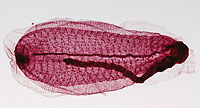
Mangrove Tunicate, Ecteinascidia sp., stained whole mount.
See also labeled photo (2 views shown)
|

Larvacean, Oikopleura sp.?, stained whole mount.
See also labeled photo
|
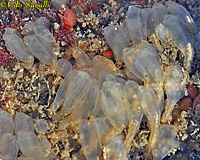
Club-shaped Ascidians, Euherdmania claviformis; La Jolla, CA.
|
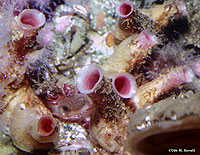
Tunicate, possibly Pyura sp.
|
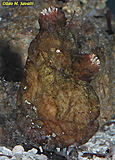
Sea Peach, Halocynthia aurantium
|

Stalked Sea Squirt, Styela clava
|
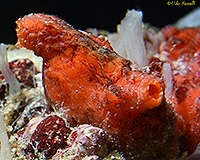
Solitary Tunicate, probably Microcosmus sp.; collected in FL.
|

Pyrosome colony, Pyrosoma atlanticum, a colonial, pelagic tunicate (preserved specimen)
|
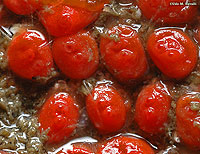
Social Tunicate, Metandrocarpa taylori; La Jolla, CA.
|
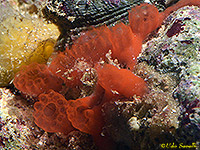
Button Tunicate, Distaplia corolla; a colonial form; collected in FL
|
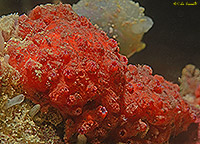
Red Colonial Tunicate, probably Symplegma rubra; collected in FL.
|
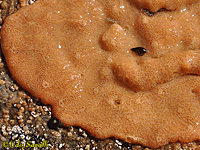
Colonial Tunicate, probably Didemnum sp.; La Jolla, CA.
|
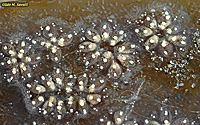
Pacific Star Tunicate, Botryllus sp.; a colonial form; La Jolla, CA.
|
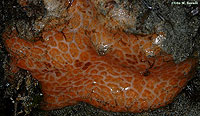
Sea Pork, Aplidium sp.; a colonial form: each small orange spot is a single individual; La Jolla, CA.
|
|
Subphylum Vertebrata — Vertebrates
Characteristics
- Brain enclosed in cartilagenous or bony cranium
- Fewer pharyngeal gill slits (used for respiration instead of feeding)
- Notorcord supplemented by or replaced with segmented vertebrae in most
- Larger, more complex brain and sense organs
- More complex visceral organs
- Includes fishes (jawless, cartilagenous, and bony), amphibians, reptiles, birds, and mammals
|
Vertebrates are not covered in this class.
To learn more about this subphylum, consider enrolling in BIO 370.
|
|
|





















